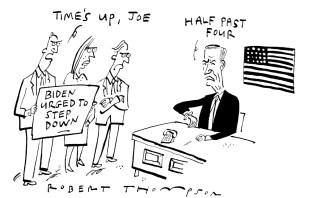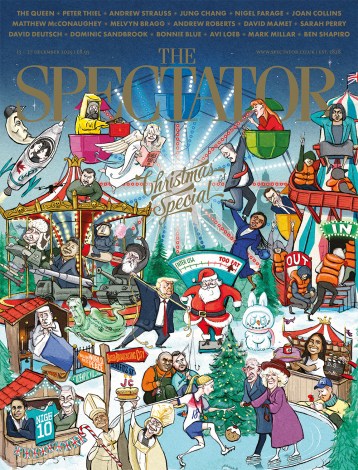Whatever happened to the likely lads and lasses of the East London art scene at the high noon of Cool Britannia? Hari Kunzru’s seventh novel, Blue Ruin, loads much else on to its ideas-rich plate – not least a pandemic yarn set in the panic-stricken spring of 2020. At its core, however, his plot traces contrasting afterlives from the Sensation generation. It reconnects three survivors – two male artists and the woman both loved – from a time when making conceptual art could feel like ‘a kind of social repair’, even a ‘utopian laboratory’.
In his earlier career, Kunzru himself seemed to belong in a gilded group of younger British authors. As with several of his peers, the opportunities of America lured him, and the promise, or peril, of Atlantic crossings underpins Blue Ruin. Recent books (White Tears and Red Pill) have carried topical themes – from ‘cultural appropriation’ to alt-right ideology – on a stream of deft story-telling about men in crisis. Blue Ruin first feeds its interrogation of the artist’s vocation, and the ‘penumbra of money’ that frames it, into a fictional memoir of high ideals and low life in 1990s Hackney bohemia, ‘riled up on cheap triples and terrible London cocaine’. Later, it stages a plague-year farce on an isolated estate in upstate New York during the ‘Armageddon time’ of the first Covid wave.
Jay, our mixed-race narrator and one-time artistic provocateur from the Thames estuary, is by 2020 a broken-down deliverer of groceries in New York. Weakened by Covid, he sleeps in his car amid ‘the anxious sweat of precarity’. By pure fluke, the app sends him to a pretty house in a vast private wood where, behind her mask, he recognises Alice, the French-Vietnamese lover who, two decades earlier, left him for his fellow artist Rob. Jay has not just disappeared from the scene but made ‘vanishing into a project’: a Reggie Perrin of the gallery game. His chance encounter with Alice – and eventually Rob, who married her and has also holed up on the estate lent to them by a plutocratic patron – prompts a deep dive into memory. It turns Blue Ruin’s first half into a sort of YBA Brideshead.
You expect bittersweet satire and savoury roman-à-clef sleaze. Kunzru niftily does some of that. But he also treats Jay’s artistic idealism earnestly, indeed tenderly. This bright lost kid shuns the creation of ‘statement objects for the rich’ in favour of performance pieces about ‘the struggle of staying alive’. The works erase themselves, as Jay will obliterate his career. Art buffs will recall Michael Landy, whose ‘Break Down’ involved the artist destroying his possessions. Alice, initially a privileged dilettante straight from Pulp’s ‘Common People’, slides from ‘disaffected princess’ to desperate junkie, trapped with Jay in her aunt’s sepulchral Knightsbridge flat. Rob, a slobby Mancunian saviour, breaks her self-destructive spell. Alice will become a super-efficient manager to this feckless but fêted man-child.
Blue Ruin resembles a collage: two (or more) novels pasted together, with each realm and register vivid but separate. After Jay’s sour-sweet London retrospect, the pandemic-era imbroglio in Alice and Rob’s security-fenced ‘paradise’ arrives with a crashing change of gear. Jay hides in a barn until discovered by gun-toting Marshal, Rob’s taskmaster-dealer, sheltering from infection with his girlfriend, Nicole. The quintet’s dialogue-driven stand-offs have a fine comic crackle: a Chekhovian sitcom vibe amid the organic veg boxes. However, this sits uneasily beside Jay’s wistful narrative of his years of drift, when he tried both to submerge himself as ‘a creature of the periphery’ and ‘deform the artworld by my invisibility’. Jittery, predatory Marshal sees that Jay’s AWOL period, his protracted ‘Fugue’, can itself be reset within ‘the frame of art’ – and, of course, profit.

Rob lurches the other way. Marshal acquires, for the absent proprietor, a painting by a ‘macho’ German heavyweight, ‘the incarnation of European seriousness’, who once employed (and exploited) Rob himself. This triggering memento sends the no-longer-fashionable ex-YBA over the edge while Jay inches towards a ‘formal close’ – and a return to art’s cash-lined fold.
With its divergent elements of Künstlerroman, period satire, think-piece and social comedy, Blue Ruin hardly manages to make its montage of styles cohere. Yet Kunzru tears zestfully into each scenario with a keen eye and ear for mood and voice, whether in rundown East London streetscapes of ‘weird gaps and hidden places’, or the elite bunkers of the early pandemic (‘That’s what it’s all about now. High security parkland’). As a portrait of the artist, and of contemporary art, Blue Ruin never quite achieves a ‘formal close’. All the same, its fragments glitter and glow.







Comments